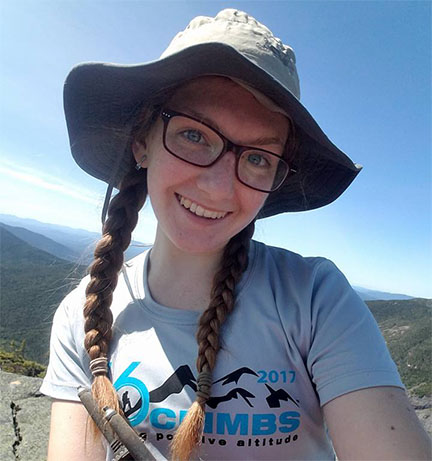
Invasive Species in the Adirondacks | How You Can Help
By: Meg Desmond - Adirondack Council Clarence Petty Intern
Thursday, June 28, 2018
What Are Invasive Species?
Invasive species are those that are not native to a particular area but are spread there through accidental or intentional means. Humans are the main contributors to this, as we regularly travel throughout different habitats, inadvertently bringing invasives along with us. Once invasives are introduced to a new environment, their populations grow quickly due to a lack of natural predators.
Why are they bad?
Ecological Health
Invasives can create extensive harm in a short period of time; ecosystems exist in a natural balance that is skewed by the introduction of a new species. There are both aquatic and terrestrial invasive species that damage their respective forest and water environments. Ponds, lakes and rivers become clogged with invasive plants, while trails become overrun and native species outcompeted.
Economic Health
The ecological health of our Adirondack Park directly impacts the economy. Protecting these habitats ensures that visitors will continue to enjoy the many components of recreation in the Park. Tourism relies on the clean waters and well-cared-for trails that so many have come to appreciate.
Human Health
Invasives also pose a threat to Adirondack residents and visitors. With new species come the diseases that they carry. Rashes, bites and burns become increased risks.
Examples of Invasives in the Adirondack Park
Spiny water fleas
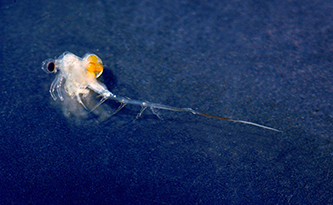
Spiny water fleas are native to Eurasia but have made their way to the US Great Lakes via ship’s ballast water. They are spread primarily by humans and since their arrival in the US, have established themselves in several water bodies in the Adirondacks: Lake Sacandaga, Peck Lake, Stewarts Bridge Reservoir, and parts of Lake George. Spiny water fleas may only be a centimeter long but their damage is significant. These fleas, easily identifiable by the long spiny tail that makes up 70 percent of their length, reduce the diversity of waterbodies and threaten the health of juvenile fish. Presently, there are no known management strategies for Spiny water fleas, therefore the prevention is the most critical action.
Eurasian Watermilfoil
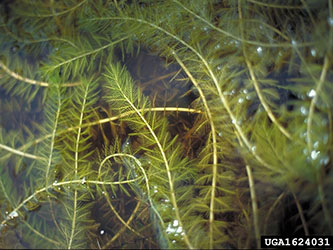
Eurasian Watermilfoil is an aquatic plant that looks similar to many native milfoil species. These plants can grow up to 20 ft. in length and create a dense layer that clogs up lakes, preventing both recreation and the survival of many natural species. Their feathered leaves can grow in a range of depths and sediment types. These leaves easily become fragmented and each piece can spread and spur a new population. Management of this invasive is intensive and can require extensive physical or chemical removal.
Loosestrife
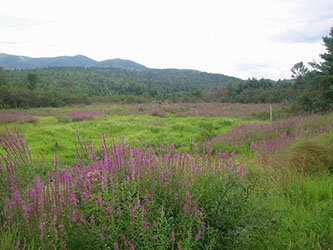
Do not be fooled by their beautiful purple flowers, loosestrife can severely disrupt the function of marshes and bog lands - two critical ecosystems. They are spread primarily through seed dispersal and can be managed only by hand removal and selective herbicide treatments.
Phragmites
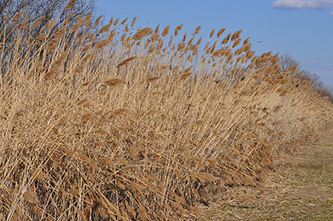
Phragmites, also called common reed grass, is an aggressive wild grass that overtakes wetlands and roadsides, growing as tall as 15 ft. These grasses impact views, damage infrastructure and reduce property values. The Department of Transportation has become the first line of defense in managing Phragmites as highway management strategies impact their spread.
Hemlock Woolly Adelgid
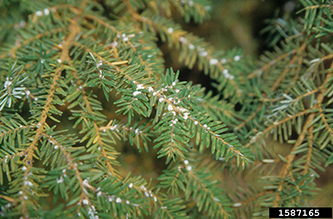
The Hemlock Woolly Adelgid is a tiny insect that feeds on hemlock trees. It can kill a tree in as quickly as four years once infestation has occurred. While they reproduce in all hemlocks, they feed on Eastern and Carolina Hemlocks exclusively. They are named for the white woolly covering on mature females.
Emerald Ash Borer
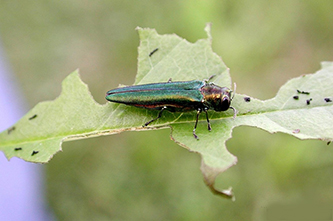
The Emerald Ash Borer is a greenish gold beetle with a purplish red abdomen that is about ¾ inches in length. These insects prey on native ash trees and have killed tens of millions of trees in the United States. Eradication is no longer an option so reducing the transport of infested ash products can slow the spread of these pests.
How you can help stop the spread
These unwanted hitchhikers can travel on you, your gear and even your pets. It is important to take the following steps and do your part to protect the Park from invasives.
Aquatic Prevention
Aquatic invasives can hang on to boats, trailers, paddles, and can be transported via bilge and ballast water. The three tenets of aquatic invasive prevention are clean, drain and dry. Before travelling between water bodies, the first step is to clean plant debris, mud and sediment from boats, trailers, and anything else that came in contact with the water. Washing can be done at one of the free wash stations in the Adirondacks. Draining vessels prevents the invasives from travelling within standing water. Check all compartments, live wells, motors, and bilge tanks for standing water. Once equipment is cleaned and drained, it is important to let it dry for at least 48 hours. The ideal is five full days and smaller vessels like kayaks can be towel dried by hand.
Terrestrial Prevention
Invasives can also latch on to clothing and gear. Brushing mud from boots and clothes at the end of the day can prevent seeds from travelling with you. Regularly washing gear further halts the spread of any unseen invasives.
When camping and making fires, only use wood from the area that you are in. If you burn it where you buy it, you can prevent the spread of invasives by keeping organic materials in the same place.
In addition to being an important Leave No Trace principle, staying on trail limits the opportunity to pick up and spread seeds.
Our four-legged friends can carry hitchhikers as well. Brushing and bathing your dog contributes to the prevention of spread.
How to Report Invasive Species
The Adirondack Invasive Plant Program (APIPP) offers trainings that teach the identification of common terrestrial and aquatic invasives. They also provide information so that you can view the locations of infestations and record your own sightings.
|

